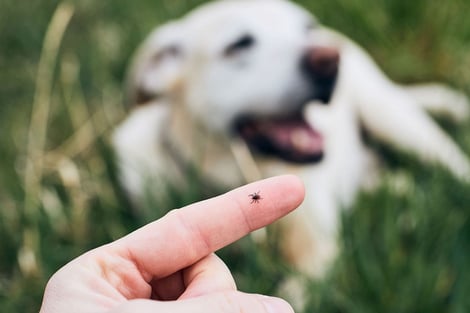Ick! A Tick! The Dangers of Tick-Borne Diseases in Dogs

Being a pet parent is a joy. But it can involve some icky tasks. Removing a tick from your dog or cat is one of them.
These tiny creatures are more than just icky; they can pose dangerous threats to your pet’s health, and your own.
What do pet parents need to know about preventing tick-borne diseases?
Common Ticks and Tick-Borne Illnesses
There are several diseases that dogs (and even cats) can get from tick bites. There are several types of ticks that are commonly found in Northeast Ohio (NEOH), including the blacklegged (deer) tick, the American dog tick, and the Lone Star tick. These nasty little creatures can spread dangerous diseases to pets, including Lyme disease, ehrlichiosis, babesiosis, anaplasmosis, Rocky Mountain spotted fever, tick paralysis, and more. And if ticks bite people, those people can also get diseases from ticks. These diseases can cause a wide variety of symptoms that can be confused with other diseases, so the best thing to do if you see that your pet is not acting like themselves is to schedule an appointment with your pet’s veterinarian.
The best way to prevent these diseases in your pet include getting the Lyme vaccine and keeping your pets away from tick‑infested environments in your yard or other outdoor places where your pets may roam. The following table gives a broad overview of the three tick types, the animals that help them breed, the environments where they are often found, the types of diseases that they can spread, and the time of year they are prevalent.
|
Tick |
|||
|
Hosts |
White‑tailed deer |
Three different hosts—can be found in many different-sized animals |
Three different hosts—can be found in larger animals like white‑tailed deer |
|
Environment where ticks like to wait for animals, pets, or people |
Forests and shrubs near forests, tall grasslands |
Forest edges, grassy fields, scrubland, along walkways, sidewalks, and trails |
Woodlands with dense undergrowth and where (wild) animals like to rest |
|
Diseases found in pets or people living in Ohio |
Lyme disease Anaplasmosis Babesiosis |
Rocky Mountain spotted fever |
Rocky Mountain spotted fever Ehrlichiosis |
|
Time of year they can be found in Ohio |
All year round |
March to August |
March to September |
Checking for Ticks and Removing Them Safely
If you’ve been out on a walk, a hike, or to the dog park, it’s always important to check your animal for ticks. Ticks are small, but they can be seen with the naked eye. Young ticks (larvae and nymphs) are especially small, and they can also spread diseases. Thankfully, it’s possible to see ticks before they attach themselves to your dog or cat. Check around faces, necks, ears, armpits, and between toes. Ticks like to hide in those spots. And keep in mind that some people mistake nipples for ticks (or growths). Male and female dogs and cats have nipples, so leave them be!
If you do find a tick that is latched on to take a blood meal on your pet (or on yourself), removing it as soon as possible is best. It may take several days for some diseases to be spread from the tick to your pet (or you), so you have some time.
In this article, veterinarian Sara Bledsoe gives some tips for getting a tick off an animal.
- Use tweezers to grab the tick close to the animal’s skin. But don’t pinch the pet or squeeze the tick.
- Pull the tick out slowly and steadily, without twisting or jerking. You want to get the head with the body.
- Check to see if you have the full tick.
- If the head looks like it’s still in your pet’s skin, ask for a veterinarian’s help instead of trying to dig it out.
- Kill the bugger by putting it in a jar of isopropyl alcohol. That’s so you can have the tick to show the vet if your animal gets sick later.
- Clean and disinfect the bite area.
If you want to know what kinds of ticks are in your area, or what kind of tick you just pulled off your pet, this Field Guide to Ticks is helpful.
A Guide to Tick Preventatives
The best way to deal with ticks is to stop them from biting your pet to get a blood meal. Your veterinarian will help you find the right kind of preventatives to use on your pet, based on your pet’s lifestyle. Many medications are good for preventing ticks, fleas, and other parasites. These combination medications may be more expensive, but it’ll likely be cheaper than treating any diseases that any of those parasites can give your pet.
It's tempting to go online and get preventatives through discount online stores, or to go to a local feed or tractor store and leave out your veterinarian in the process. However, it’s best to ask your veterinarian what products are best and which suppliers are trustworthy. The cheapest medication might not be the right medication, or it might not be stored properly before you get it, making it useless for protecting your pet.
If you decide not to check in with your vet before you get any preventative medications, you’ll need to be very careful. Cats aren’t dogs, and dogs come in different sizes, so you need to make sure that the medication is labeled to treat your kind of pet (dog OR cat), which can also be based on the weight of your pet. You need to be able to apply the medication so that it works as it was designed. Most importantly, you need to make sure that the dose won’t be too strong for your pet. I’ve seen too many videos of pets that were given the wrong medication, or the wrong dose, and the pet has a bad reaction and has to be rushed to the vet clinic for proper care.
Some preventative options are:
- Oral medications
- Spot‑on treatments
- Flea and tick shampoos
- Insecticide dips
- Collars
There are ways that you can make your yard less friendly for ticks to hang out.
- Sprays for pets or treatment for your yard or lawn can work too. But some animals, pollinators, and humans are sensitive to chemicals, so proceed with caution.
Stay on Top of Ticks
When you visit your vet, ask them what they recommend for preventing ticks. They will have a good idea of which types of ticks are a problem in your area, and they can recommend products or medicines that can help.
Consider vaccinating your dog against Lyme disease. You might feel relieved knowing they are protected against this illness that is a growing issue for pets and humans.
And if you see a tick on your pet, don’t panic. If you catch it early enough, it might not develop into a problem.
Just take a deep breath—and get the sucker off.

